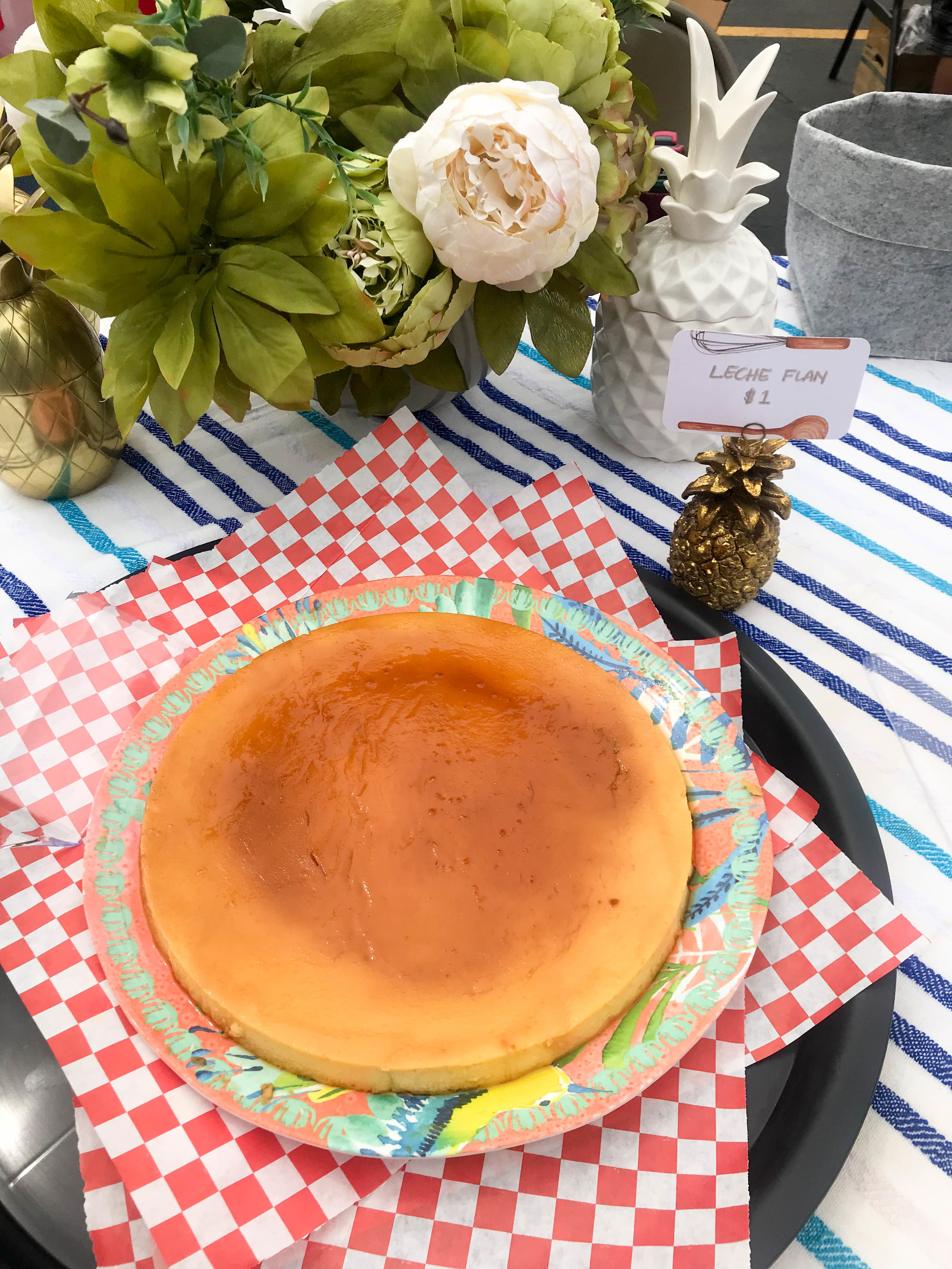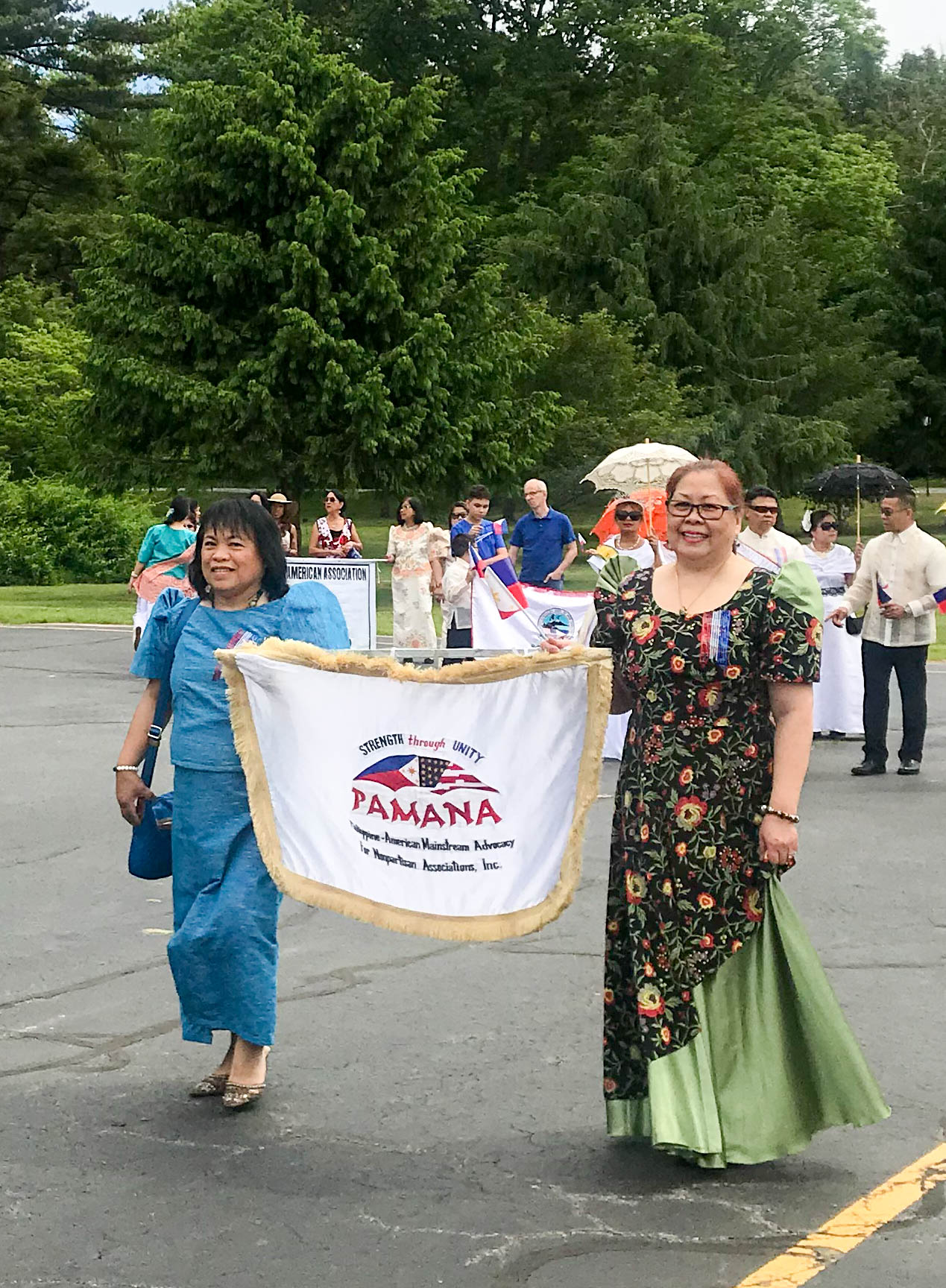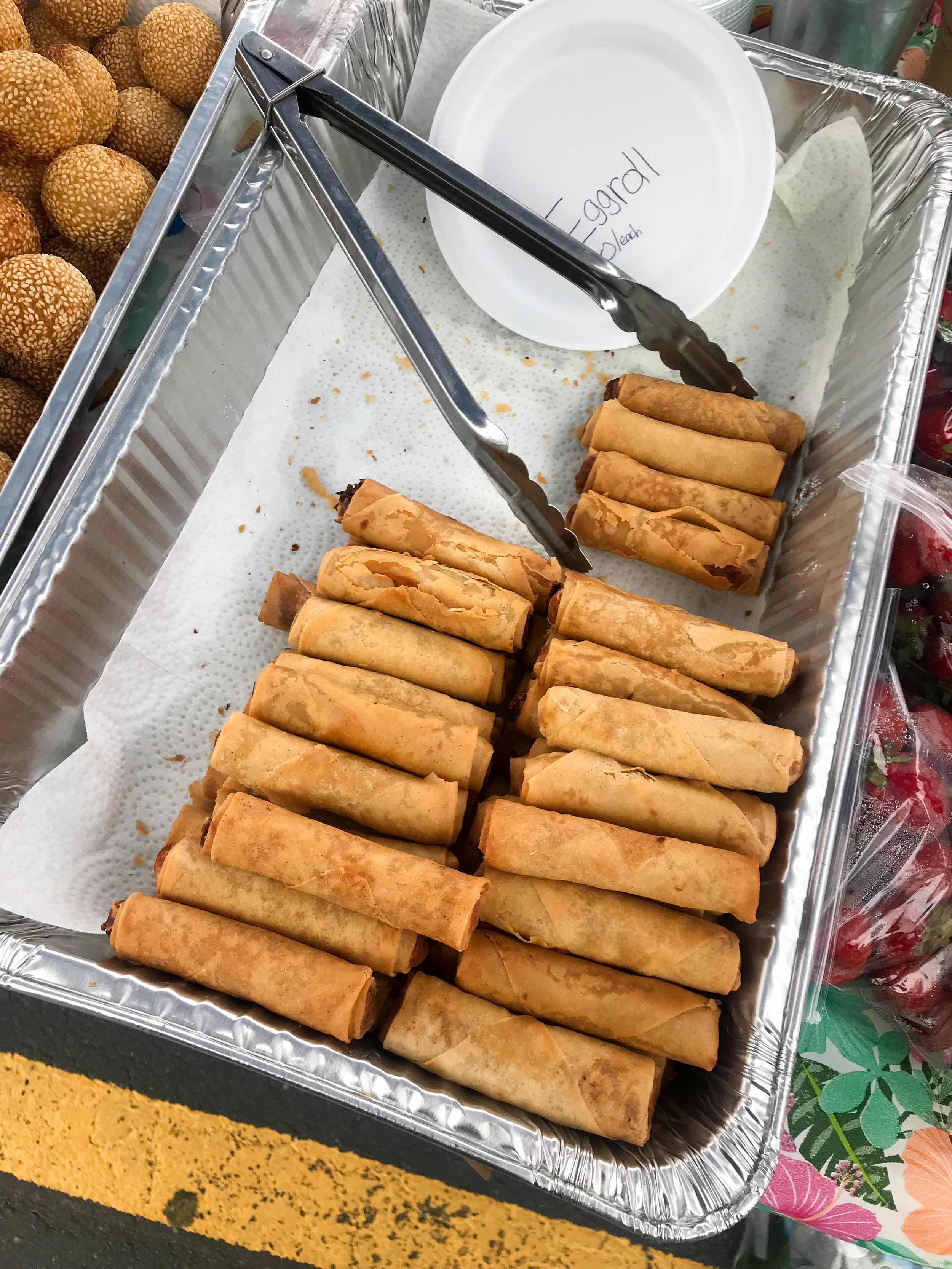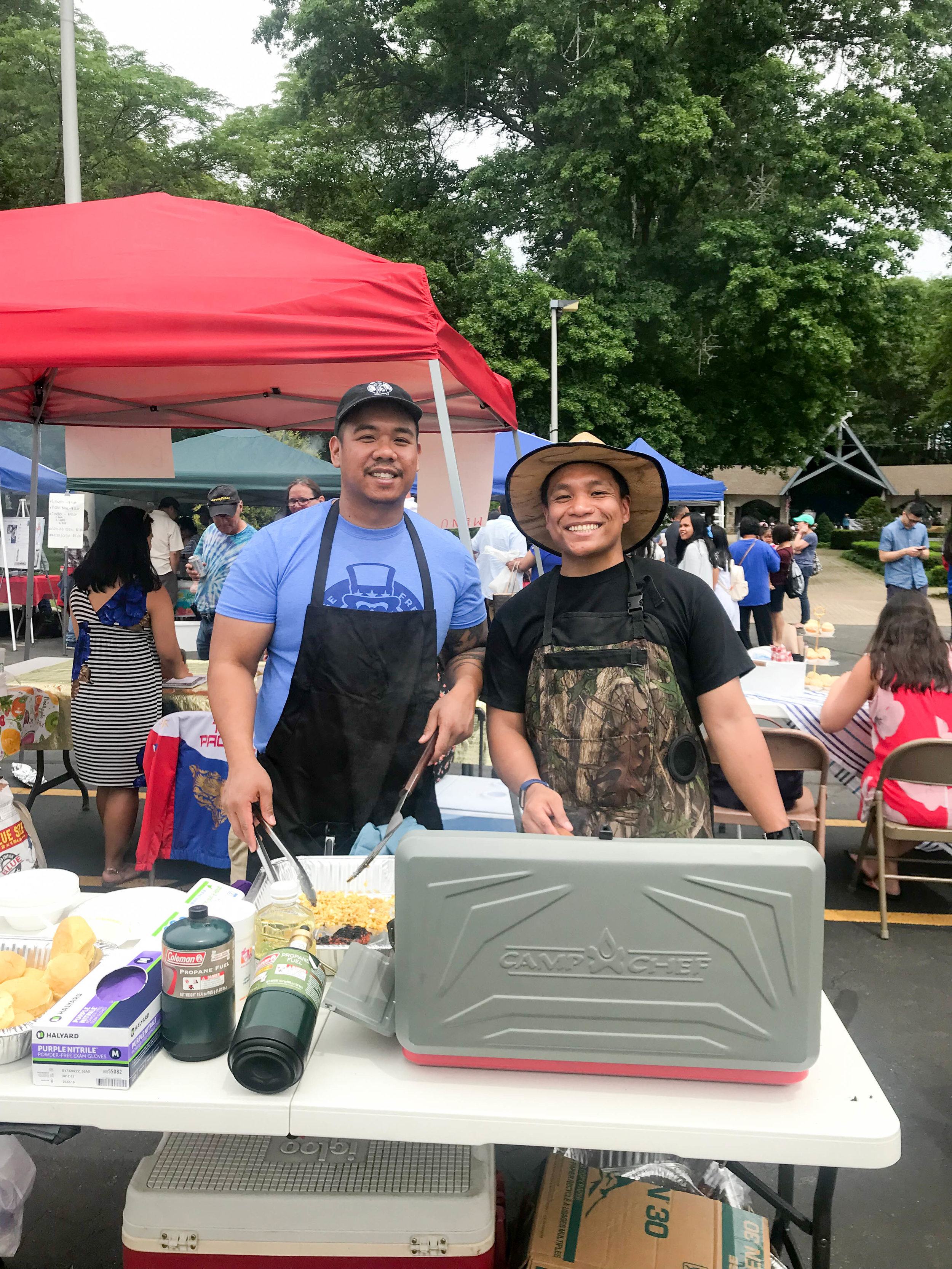[RECIPE] Filipino Style Corned Beef
By Bianca Garcia
I’ve loved breakfast food for as long as I can remember, and there’s nothing I love more than a Filipino breakfast.
Give me kesong puti (buffalo mozzarella), pan de sal (breakfast rolls), and tsokolate (hot chocolate). Give me sinangag (garlic fried rice) paired with any of our traditional breakfast meats. Any time, any day, and I will be happy.
I love the concept of “-silog” which is an abbreviation of the words sinangag and itlog (egg), essentially fried rice and fried egg, typically served with longganisa (breakfast sausage), tapa (thinly sliced beef sirloin), Spam, or corned beef.
Today I want to share my recipe for corned beef - and I’m not talking about the boiled corned beef with cabbage - but rather, canned corned beef that’s sauteed with potatoes, garlic, onions, and tomatoes. Corned beef that’s served with garlic fried rice and fried eggs. Corned beef that’s been a breakfast staple for many Filipinos like myself.
My husband Matt (who is not Filipino, but has embraced Filipino culture and Filipino food) and I often make corned beef for brunch during the weekends. We stock up on our favorite canned brands (Delimondo from the Philippines, and Palm brand from Asian grocery stores) and always have the rest of the ingredients on hand, so it’s an easy meal to whip up. We usually make garlic fried rice and fried eggs to eat with the corned beef, but sometimes we just do plain rice, sometimes scrambled eggs. Sometimes I don’t have tomatoes, sometimes I have too many potatoes, but it still always turns out delicious.
Filipino Style Corned Beef
1 can corned beef (depending on the brand, cans range from 11 oz to 14 oz)
For this recipe, I used Delimondo Garlic and Chili Corned Beef
2 tablespoons olive oil
2 medium yellow potatoes, peeled and chopped into half-inch cubes
1 small white onion, chopped
2 cloves garlic, minced
1 cup cherry tomatoes, each tomato sliced in half
Salt and pepper to taste
Directions
Heat 1 tablespoon oil in a large pan over medium heat. Add potatoes and cook until softened, stirring to make sure they don’t brown too much, about 7 minutes.
Pour remaining oil and add onions to pan. Saute onions and potatoes, until onions begin to soften, about 5 minutes.
Add garlic to pan, and saute with onions and potatoes until fragrant, about 3 minutes.
Add tomatoes to pan, and cook until tomatoes start to release juices and burst from the skin, about 3-5 minutes.
Add corned beef to pan, and cook until beef is fully heated. Season with salt and pepper.
Increase heat to medium-high and cook corned beef mixture to your desired dryness. (I like getting some crisp and charred bits of corned beef.)
[Recipe] Baked Filipino Torta
By Bianca Garcia
Picture provided by Bianca Garcia.
I grew up eating torta. I ate it for breakfast, lunch, or dinner, always served with fluffy white rice. Torta was one of my family’s go-to dishes, made with simple ingredients that even picky eaters would appreciate. It’s essentially a round omelette with ground pork, onions, and potatoes.
It is sometimes referred to as “tortang giniling” (giniling = ground) because it is made with ground meat, typically pork or beef. This distinguishes it from different versions of torta. For instance, there’s “tortang talong” (talong = eggplant). There’s “tortang gulay” (gulay = vegetables), that’s made with different veggies like squash, bittermelon, cabbage, etc. There’s also a dish that is a combination of the above: tortang talong (eggplant) stuffed with ground beef. That dish is called a rellenong talong (relleno refers to anything that is stuffed) but then we are going on a different topic, and I’m here to talk about torta. Specifically ground pork torta.
The torta we eat at home in the Philippines is made painstakingly by my Tita Ine. It has teeny tiny cubes of uniformly cut potatoes that mingles seamlessly with the juicy ground pork, all in a delicate frittata-like casing, flavored simply with white onions and salt (never pepper). She cooks the ground pork first, then the potatoes and onions, adds in eggs that have been whisked into submission, and then flips the entire pan into a plate, and transfers it back to the pan to cook the other side. I’ve tried many times to recreate her recipe and follow her instructions, but it never turns out the same because 1) my knife skills are not great / I don’t have the patience to cut teeny tiny cubes of potatoes, 2) my flipping skills need work (there’s been more than one occasion of a torta gone wrong), and 3) I always seem to overstuff my torta and it doesn’t exactly come out as a delicate piece of art.
So I decided to make my own, easier, non-intimidating version. I made a few updates: 1) I roughly chop the potatoes into half-inch cubes, 2) I bake the torta, which saves me the stress of flipping it, and 3) I use a deep dish pan so even if it’s overstuffed, things don’t spill out of the pan, and instead it comes out as one big sturdy-looking frittata.
Below is my own recipe, which my husband and I make at least every other week. It has the same flavors as the torta I grew up with, and it still goes very well with white rice. But it also goes well with an arugula salad, or a sandwich (with a little smear of mayo, yum), or just eaten by itself. I like dipping it in ketchup, but some people like fish sauce or soy sauce.
Picture provided by Bianca Garcia.
Baked Filipino Torta by Bianca Garcia
Ingredients
1 tablespoon olive oil
1 lb ground pork
2 medium potatoes, chopped into ½ inch cubes
½ cup chopped white onions
6 large eggs
Salt to taste
Directions
Preheat oven to 350 F.
On the stovetop, heat olive oil in a large oven-safe pan over medium-high heat (you can use a cast iron skillet or a non-stick pan). Add ground pork. Stir often and break up clumps with a wooden spoon. Cook until browned, about 10 minutes. Season with salt. Remove pork from pan and set aside.
Reduce heat to medium. Add potatoes and cook for about 3 minutes, and then add onions. Cook until onions are translucent and potatoes are soft.
Beat the eggs with a generous pinch of salt.
Add eggs to pan. Let sit on stovetop for a minute or two, until edges start to set, and then transfer to oven.
Bake for 12-15 minutes, until eggs are set.
Slice into wedges and serve.
I know that torta could mean different things for different cuisines: it could be a Mexican sandwich, a Spanish flatbread, an Italian cake, a Brazilian pie. But to me, it’s an egg concoction with ground meat and veggies. To me, it has always been Tita Ine’s torta. And now, it’s mine, too.
We’re always looking for BOSFilipinos blog writers! If you’d like to contribute, send us a note at info@bosfilipinos.com.
Todos Los Santos in the Philippines
by Bianca Garcia
Do you celebrate All Saints’ Day? I do, and lately the movie Coco has been on my mind. I love how the movie showcased Dia de Los Muertos (Day of the Dead), when big throngs of family and friends congregate at the cemetery to commemorate their loved ones. The movie tugged at my heartstrings because it reminded me so much of how we celebrate Todos Los Santos (All Saints’ Day) in the Philippines.
Each year on November 1st, Filipinos swarm to the cemeteries to honor our beloved family and friends who have passed away. Some families would come the previous day, some would come the next day (on All Souls’ Day), and some would stay there for the three days. Some people camp out and spend the night, and the cemeteries are literally packed with people, food, light, flowers, candles, and music.
The energy during Todos Los Santos is anything but sad. The holiday has become a de facto family reunion, so there’s a jovial feeling in the air. Filipinos honor our loved ones who have passed by bringing their favorite foods, reminiscing about them, praying for them, and keeping our memories of them alive. There is something very uplifting about celebrating the lives of our dead, instead of mourning their deaths.
In my family, we go to two cemeteries - one for my mother’s side, and another for my father’s side. We bring food, we pray, we catch up with our relatives. The kids play, the adults talk, we all eat and enjoy our time together. I am sad that some of my family have passed too soon: Lolo Ising, Lolo Leno, Lola Nading,Tito Jun, Ate Isabel. But I am also happy that I still have them in my life - through my living relatives, and through Todos Los Santos.
*Quick Filipino vocab:
Lolo = grandfather
Lola = grandmother
Tito = uncle
Ate = older sister
PAMANA Filipino Parade and Festival
By Bianca Garcia
We had a blast celebrating the 120th Philippine Independence Day with PAMANA (Philippine-American Mainstream Mainstream Advocacy for Nonpartisans Associations) last weekend. We ran a dessert booth in collaboration with BOSFilipinos and Confessions of a Chocoholic, and it was a hit! I made mini ensaymadas, Leila made leche flan, and our friend and BOSFilipinos member Val made calamansi bars.
Here are some pics from the day:
After the parade, there were some welcome comments, a flag raising, and various types of performances. And of course: Filipino food in abundance. Quintessential Filipino foods like lumpia, longsilog (longganisa + sinangag + itlog) plates, pancit, BBQ, halo-halo, and other snacks fueled us throughout the day and brought us a taste of home.
Our neighbors at the next booth were the Pulutan Boyz, Philjay (you may have seen him at BOSFilipinos events) and Mac, slinging longganisa and tocino sliders.
It was such a fun day seeing other Filipinos and celebrating our culture together.
Thank you so much to everyone who stopped by our booth to say hello and buy our desserts! We hope we were able to entice some of you to be a part of the BOSFilipinos gang in some way. Thank you to Jen and PAMANA for coordinating the Independence Day celebration. And maraming salamat to Val for baking goodies, and to Matt for driving us all to Attleboro.
In case you missed us at the parade, don’t worry, you can find us at the next Filipino event on June 23rd at the 2nd Annual Filipino Festival in Malden. And don’t forget to sign up for our newsletter to catch up with us every month.
You can also reach out to us at info@bosfilipinos.com and tell us how else we can build on the Filipino community. Or better yet, let us know how you want to participate.
We look forward to meeting more of you soon. Mabuhay!
(More pics on our Facebook page.)
Food and Recipes Inspired by My Mom Celia
By Bianca Garcia
Continuing our May celebration of mothers, I want to talk about my mom, Celia. She is my most influential food guides. She has always been the first one to introduce me to different tastes and flavors from all over the world. I learned to love food because of her, and as fate would have it, I now have a food blog where I can share my favorite foods with the world, too.
Here are some of my mom-inspired recipes and favorite foods that I’ve shared on my blog:
kesong puti, pan de sal, tsokolate © Bianca Garcia
It all started when I was still in utero, and my pregnant mom was constantly craving and eating kesong puti, the milky white cheese that’s native to the Philippines. It’s essentially buffalo mozzarella, but creamier and fresher. According to Filipino superstition, my mom’s pregnancy craving was the main reason why I myself developed a lifelong longing for kesong puti.
sardinas © Bianca Garcia
My mom is the one who taught me to love sardinas (sardines), the Spanish or Portuguese kind, in oil and spices. I love these little sardines (that still have skin and bones), on top whole wheat bread, toasted dark, slathered with creamy butter.
key lime pie © Bianca Garcia
My mom loves key lime pie, and (surprise!) so do I. Key limes are smaller than regular limes, with a more yellowish skin, instead of bright green. They are very similar to Filipino calamansi. I would juice a million key limes by hand for my mom!
(Here’s my easy recipe for Key Lime Pie.)
caramel thumbprint cookies © Bianca Garcia
My mom cannot turn down anything “turtle” flavored - chocolate, caramel, pecans. These little turtle cookies are a nice little treat. Like me, she enjoys dessert. But unlike me, she’s typically content with smaller portions (ha!).
(Here’s my recipe for Caramel Thumbprint Cookies.)
My mom makes me feel like I can do anything. She believes that I can go to Harvard, land my my dream job(s), star in a TV show, rule the world. Thanks to her encouragement and support, I have done it all. Well, I’m still waiting on that last part, but Beyonce says we already run the world anyway…
Her faith in my cooking also helped me finally recreate her famous pasta sauce, which is like a mixture of a bolognese with a surf and turf plate. It’s a meat-lovers sauce (ground beef + bacon + Italian sausage) with big juicy shrimp. It’s as mouth-watering as it sounds.
(Here’s the recipe for My Mom’s Pasta Sauce.)
mini almond cinnamon buns © Bianca Garcia
When I see any kind of citrus marmalade - orange, lemon, grapefruit - I immediately think of my mom. And when I see a breakfast treat or pastry studded with nuts - almonds, pecans, walnuts - I think of my mom as well. I wanted to make a citrusy breakfast inspired by her favorite flavors, and landed on little cinnamon buns with almond paste, slivered almonds, and Meyer lemon marmalade.
Meyer lemons, by the way, are like a cross between a lemon and an orange. They’re sweet and not as tart as their more ubiquitous cousins. They’re also smaller with a thinner skin that has a slightly more orange tint, and they come into season during mid-winter to late spring. They remind me of Filipino dalandan.
(Here’s my recipe for Mini Almond Cinnamon Buns.)
crab cake linguini © Bianca Garcia
Even though I’m a woman in my thirties, I am not exactly adept at eating crab, one of my favorite seafoods. That’s because whenever I’m home or with my parents, I turn into a child and ask my mom to do the work for me. Shell the crab, pick the meat, open the claws – the whole show. She’s just so adept at it! (And I’m too lazy.) My mom and I both love crab cakes, so I made this easy but luxurious-tasting linguini with crab cakes.
(Here’s my recipe for Crab Cake Linguini.)
cheesy anchovy toast © Bianca Garcia
Last but not least, since my mom was the one who influenced my love for anchovies and all things cheesy (melted cheese, snacking cheese, cheesecake, cacio e pepe - if it has cheese, give it to me) I recently made this anchovy toast. Crunchy bread, garlicky cheese spread, and salty anchovies, finished with a shower of chopped chives and red pepper flakes. The flavors are unapologetically strong, not for the fainthearted, and perfect in every way.
(Here’s my recipe for Cheesy Anchovy Toast.)
Bianca and Mom in the 80s © Bianca Garcia
Thank you, Mommy, for introducing me to the foods that have become my favorites <3
I hope I was able to inspire some of you to make something delicious and enjoy it with your mom and loved ones!
Filipino Chicken Adobo Recipe
By Bianca Garcia
© Bianca Garcia
During one of our early BOSFilipinos meetings, Leila, Trish, and I talked about our family’s version of adobo. I said my family’s is very vinegary, Trish said her family’s is a little sweet, and Leila said her family’s is pretty balanced, with equal amounts of soy sauce and vinegar. We all said our family’s version is the best.
If you don’t know yet, adobo is any meat or any combination of meats that is are braised and simmered in vinegar, soy sauce, lots of garlic, black peppercorn, and bay leaves. Saveur wrote a good Beginner’s Guide to Adobo. It’s the unofficial national dish of the Philippines, so ingrained in our culture, that just the thought of the fragrant stew can make any Filipino think fondly of home.
One of the wonderful things about adobo is you can alter it in many different ways to make it your own. You can change the ratio of vinegar and soy sauce, you can use different meats (my family’s go to is pork and liver) or vegetables (my favorite is sitaw, or string beans), you can add coconut milk, a little sugar, onions, ginger, hard-boiled eggs, chilies. However way you make it, I’m sure it will be delicious. And pretty soon, you’ll be claiming your version is the best.
CHICKEN ADOBO Recipe by Bianca Garcia
INGREDIENTS
6 chicken thighs (bone-in, skin-on)
1 ½ cups vinegar
½ cup soy sauce
10 garlic cloves (around 1 whole head of garlic), smashed
1 tablespoon whole black peppercorns
1 teaspoon coarse salt
8-10 dried bay leaves
1 cup water
1 tablespoon olive oil
fresh chives for garnish
DIRECTIONS
Place the chicken, vinegar, soy sauce, bay leaves, salt, peppercorns, and seven of the smashed garlic cloves in a heavy pot over medium heat. Add one cup water, plus more if necessary, to barely cover the meat. Bring to a boil, then reduce the heat to medium and simmer, covered, for 30 minutes.
Remove the cover and simmer, uncovered, for another 30 minutes.
Use a slotted spoon to remove the chicken and set aside. Increase heat to high and allow the broth to continue simmering.
In a large skillet, heat olive oil over medium-high heat. Add the remaining garlic cloves. Add chicken and sear each piece on both sides until golden brown and skin is crispy.
Return chicken to the pot, and continue reducing the sauce by simmering for at least 10 minutes, stirring occasionally, until the sauce thickens to your liking. Serve with white rice, and garnish with chives, green onion, and/or chilies.
If you’d like to read more of my story, check out my post on Filipino Chicken Adobo on Confessions of a Chocoholic.
And If you’d like to explore other variations, check out the following recipes:
Chicken Adobo is the Greatest Recipe of All time by Bon Appetit
What I Cook When I’m Alone: Top Chef Winner Paul Qui’s Pork Adobo Recipee
Enjoy!
Easy Mini Ensaymada Recipe
Filipino Ensaymada © Bianca Garcia
By Bianca Garcia
I’ve made these mini ensaymadas several times already and they’re always a hit! I’m sharing my recipe for you to try out and maybe bring to your next holiday party or salo-salo (social gathering).
What’s ensaymada?
Ensaymada is Filipino pastry. It’s a soft, buttery, brioche-like bun topped with butter, sugar, and cheese. Some versions (like mine) use buttercream, some use margarine, and some even omit the cheese altogether. But if you know me, I never omit cheese from any recipe.
For most Filipinos, ensaymada is a big part of the holiday season, ubiquitous at parties and potlucks. But it’s not only available during the holidays; it’s enjoyed year-round. Ensaymada is also a staple for breakfast, merienda (mid-morning or mid-afternoon snack), or dessert. And it is often served with coffee or tsokolate (hot chocolate).
Filipino Tsokolate © Bianca Garcia
The cheese that’s typically used to top ensaymada is queso de bola, a special kind of edam cheese that’s manufactured only for the Philippines, and available during the holidays. I used a micro-plane to shred the queso de bola, resulting in extra fine shavings that I then used to generously blanket the top of each pastry. Queso de bola is hard and crumbly, similar to Parmesan, so if you don’t happen to have a ball of Filipino cheese within easy access, you can always substitute parmesan. You can also use sharp cheddar cheese.
I used a shortcut in this recipe by using pre-made dough in the form of crescent rolls. This saves a lot of time, and it makes the recipe more accessible and less intimidating for me. If you’d like to make the dough from scratch, I like this recipe by Jun-Blog.
RECIPE (originally posted on Confessions of a Chocoholic):
MINI ENSAYMADA
INGREDIENTS
- 1 tube (8 oz) crescent rolls
- 2 tablespoons butter, melted
- 1/2 stick butter, room temperature
- 1/2 cup confectioners sugar
- 1/4 cup shredded queso de bola (I used a microplane for extra fine shavings)
DIRECTIONS
- Preheat oven to 350 F.
- Unroll dough. Separate into 2 rectangles. Most crescent roll dough includes 8 triangles, so for this recipe, each rectangle will be made up of 4 triangles. Pinch the perforations together. Flip over and pinch the perforations on the back together, too. Use a rolling pin to smooth out the seams and flatten the dough a little bit.
- Brush the rectangles with melted butter, and roll each rectangle into a log. Cut each into 8 pieces, so you'll end up with 16 pieces total.
- Using a pastry brush, grease mini muffin tins with the remaining melted butter. Insert buns and bake for 11-12 minutes.
- While buns are baking, make the buttercream. In a medium bowl, combine the room temperature butter and confectioners sugar. Cream together until smooth.
- Once buns are lightly golden, remove from oven and let cool for 15 minutes.
- Spread buttercream on top of each mini bun and generously top with cheese. Serve immediately or keep in an airtight container.
Of Cockfights and Adobo
by Bianca Garcia
© Bianca Garcia
This is an excerpt of an article I wrote for Offline Magazine (now shuttered down). I wanted to write about a controversial local tradition, and weave in stories about my family and food (of course). The entire piece is published on my blog.
--
I stared at the gates outside the arena, gray and rusty, paint peeling off. The scorching sun was beating down on us, bright and relentless, and on the ground there were clouds of dirt being kicked around by the flip flops that everyone wears. There were sounds of children playing nearby. It was a typical provincial scene, grand and quaint at the same time. We shuffled to the entrance, and then we entered a different world.
We were at the cockfighting arena in San Fernando, Pampanga, a province in the Philippines. Dark, humid, loud and thumping, I could feel a frantic energy pulsing in the air. It was my first time going to see a cockfight, or “sabong” as it is called in Filipino. Cockfighting is a blood sport so violent that it’s outlawed in many other countries, but it has been part of Filipino culture for centuries.
In the Philippines, cockfighting is a great equalizer, where the rich and poor come together without any class distinctions. It is a community activity that brings neighbors together and ignites the bonding of the townsfolk’s men. A common joke among the wives is that the roosters are luckier than they are, because their husbands caress and lovingly massage the roosters first thing in the morning. Up until the 60s, when most parts of the country started becoming more urbanized, almost every backyard had chicken and rooster coops, with every family being invested in the sport of cockfighting.
To read the rest of the article, please head over to Confessions of a Chocoholic.
BOSFilipinos and Milagros Project Pop-Up Dinner Recap
by Bianca Garcia
My heart was beating fast, my hands were sweating, and I smelled like adobo. I glanced around the cozy space at Saus and saw my team whirring around: Trish was going over the floor plan and putting last minute touches on the dining tables, Leila was prepping garnishes behind the counter, Saima was heading down towards the kitchen with a determined look on her face, and Chef Roland was laser-focused on the food, carrying big pots filled with deliciousness. I grinned wide and welcomed the first guest. We were ready to rock and roll.
Clockwise from top left: Leila, Roland, Bianca, and Trish
© Bianca Garcia
The next few hours went by in a blur. We were fortunate to have sold out both seatings for the evening, and there was a general buzz of excitement in the packed restaurant that sustained throughout the night. Once the food started coming out, we heard plenty of “oohs,” “ahhs,” and “mmms.” The diners were happy and satisfied, and so were we. The Filipino Food Pop-Up Event by BOSFilipinos and The Milagros Project was a success! Below are a few pictures from the evening:
scallop kinilaw
© Matt Nagy
ilocos empanada
© Matt Nagy
chicken inasal steeam bun
© Matt Nagy
pork ribs adobo
© Matt Nagy
leche flan
© Cathy Buena
Chef Roland talking to diners
© Bianca Garcia
happy diners
© Bianca Garcia
the night's menu (hapunan means dinner in Filipino)
© Matt Nagy
dried mangoes and bananas
© Bianca Garcia
We are all grateful for this incredible experience. The months of preparations and meetings (filled with food, no complaints) were worth it, and we are proud of our very first eat-up. Extra special thanks to: Chef Roland of The Milagros Project for sharing his talent and letting Boston have a little taste of the Philippines via his tasting menu; Chin, Lucas, Tanya, Aimee, Renee, and the rest of the team at Saus for their help and participation; our friend Saima for rocking out with us that night; my hubby Matt for designing our menu and branding; and of course to our attendees, family, and friends for the support and encouragement.
MARAMING SALAMAT PO! THANK YOU VERY MUCH!
the team post-event
© Bianca Garcia













































